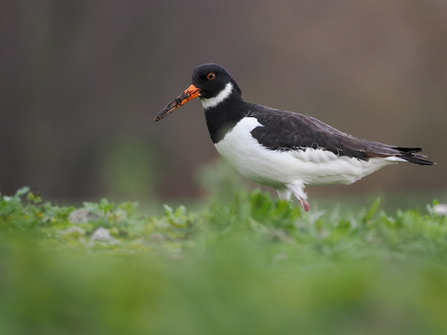
The oystercatcher was rarely seen without a muddy bill pic
Photo credit: @Elliott81758817
Barnacle geese flying in for one of their regular visits
Photo credit: @Chris_Farthing

The oystercatcher was rarely seen without a muddy bill pic
Photo credit: @Elliott81758817
It means the total for 2023 was stuck on 143 - one above last year and the same as in 2018 and 2021.The most surprising omissions were Red-crested Pochard, for the second year running, Brent Goose and Sandwich Tern which might be explained by the disastrous impact of avian flu on breeding numbers. Bird of the year was the alpine swift which hung around for two days to allow many people to enjoy it, although honourable mentions must go to the extraordinary flock of 11 spoonbills, the elusive little owls and iceland gull.
Barnacle geese flying in for one of their regular visits
Photo credit: @Chris_Farthing
The barnacle goose flock made occasional visits to the Wetlands with 15 seen on 8th, 10th and 24th with 16 on the 22nd. Cold weather at the beginning of the month saw nine wigeon arrive on the 2nd with five more on the 18th. Goldeneye numbers remained low with up to four scattered around the reservoirs throughout the month while goosander were again scarce with fly-overs on the 5th and 10th before a drake settled for a few hours on No 2 on the 13th.

Wigeon were seen in good numbers early in the month
Photo credit: @Elliott81758817
Four species of wader were seen this month. An oystercatcher found on the 3rd was an unusual enough record given that they routinely do not return to London even on the Thames at Rainham until late January. But for it to stay throughout the month, largely around No 5 was exceptional. Even a near-death experience at the hands of a peregrine - forcing it to dive into the water to escape - did not encourage it to move on.

The oystercatcher became tamer the longer it stayed
Photo credit: @MLP
A movement of lapwing in cold spells is now expected with eight on the 1st and five more next day. Two common sandpipers were seen until mid-month with at least one staying into 2024. Green sandpipers, which seem to be becoming less regular, were recorded on the 2nd and 4th.

Lapwing, like wigeon, can be expected in cold weather
Photo credit: @Elliott81758817
In what has been a good year for scarcer big gulls, the final caspian gull of the year was picked out by RE on the 18th while DC found two Yellow-legged Gulls on the 10th. Single red kites were seen on the 1st and 13th. Small numbers of winter thrushes continued to be seen with 15 redwing feeding on berries near the Engine House on the 8th and six fieldfare flying over on the 22nd. Up to three stonechats are wintering.
A 1W caspian gull, an unusually regular visitor this year
Photo credit: @wheresrhys